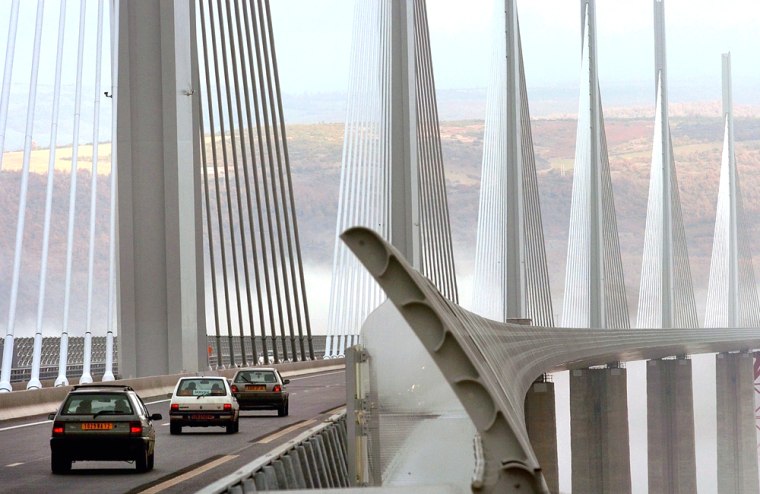They are calling it the Grand Viaduc de Millau, and the stylish language is matched by the soaring, sensuous beauty of the bridge itself.
Though its delicate lines can appear almost fragile against the mountains of southern France, it is the tallest bridge in the world.
Inaugurated by French President Jacques Chirac two days ago, the bridge opened to the delighted public Thursday morning.
Motorists were full of praise for it as they made their first journey across the bridge and over the Rhone Valley.
‘Delicacy of a butterfly’
The bridge has been celebrated as a work of art combining the strength of cement and steel with the “delicacy of a butterfly.”
Its designer, British architect Norman Foster, said of his creation that it seems to float.
He’s right. Because the cables are white, they disappear against the sky, so you have this very, very slim ribbon of road going almost through what appear to be eyes of a needle.
Supported by seven slender pillars, the roadway stretches for a mile and a half, more than 1,500 feet longer than the span of the Golden Gate Bridge. The tallest pillar stands at 1,122 feet, making it higher than the Eiffel Tower and a tad shorter than the top floor of the Empire State Building.
Stretching through France’s Massif Central Mountains, the roadway, which sits 885 feet above the Tarn River below, is supported by a graceful spider web of cables.
“A work of man must fuse with nature. The pillars had to look almost organic, like they had grown from the Earth,” said Foster, who also designed London’s Millennium Bridge.
Cutting-edge technology
The bridge took only three and a half years to complete, and its technology is even more cutting edge than the design.
Engineered and designed using advanced, new computer modeling techniques unavailable just a few years ago, the bridge at Millau was constructed piece-by-huge-piece using Global Positioning Satellite technology to precisely join the massive sections together hundreds of feet in the air.
The cost was more than $500 million and was paid for privately by Eiffage SA, the successor firm to the company that built the Eiffel Tower.
In exchange, the company received the right to collect tolls for the next 75 years. Tolls for motorists will vary from $6.50 in winter to $8.60 in summer. Trucks will have to pay $32.24 year round.
The bridge was commissioned to open a new north-south link between Paris and the Mediterranean and is expected to relieve bottlenecks caused by trucks and tourists headed to the Riviera.
Some 28,000 vehicles a day are expected to cross the bridge in the summer months, and about 10,000 a day the rest of the year, according to the Eiffage company.
